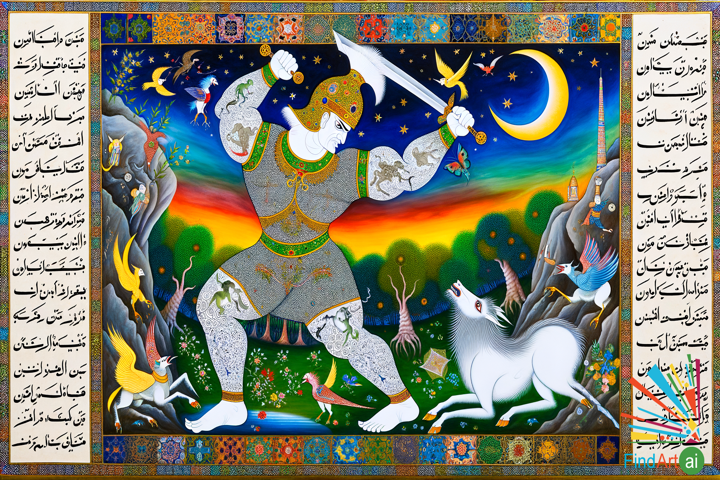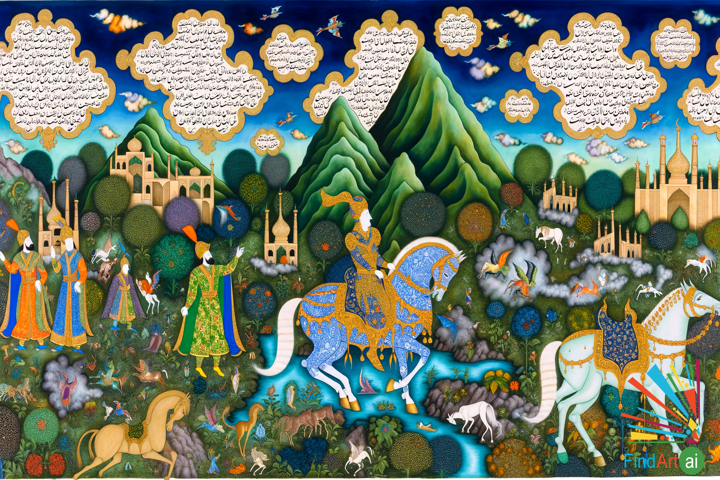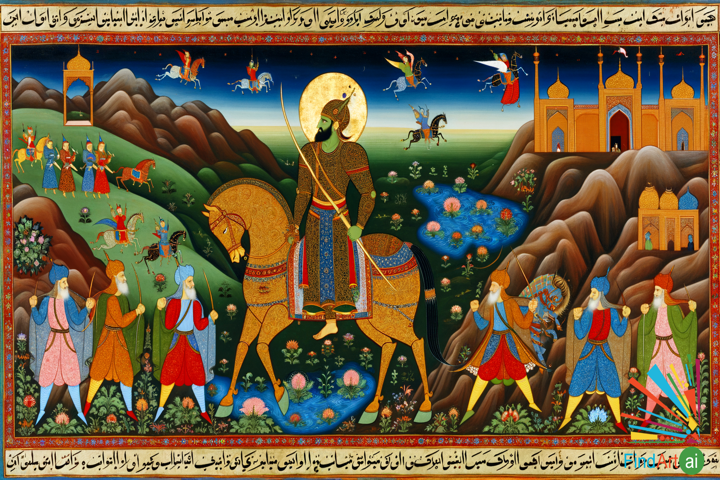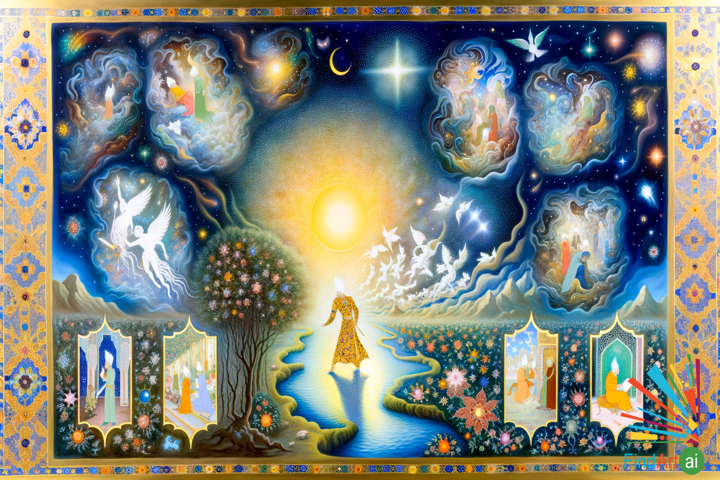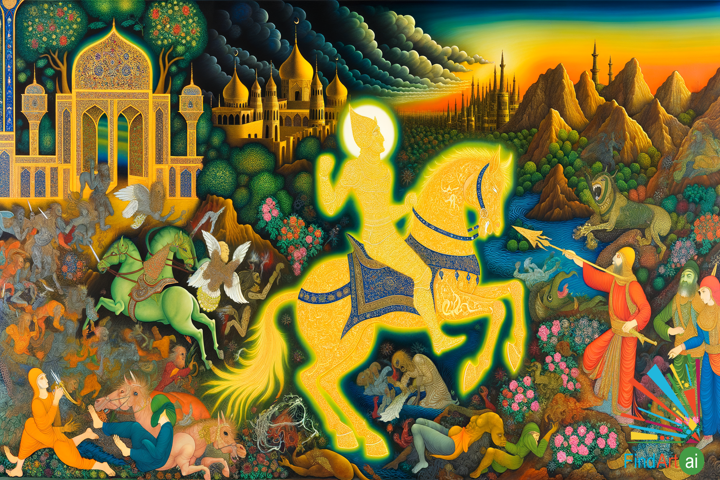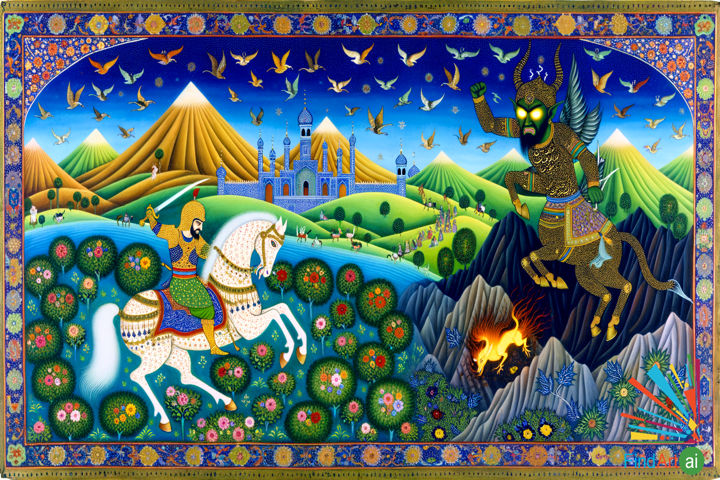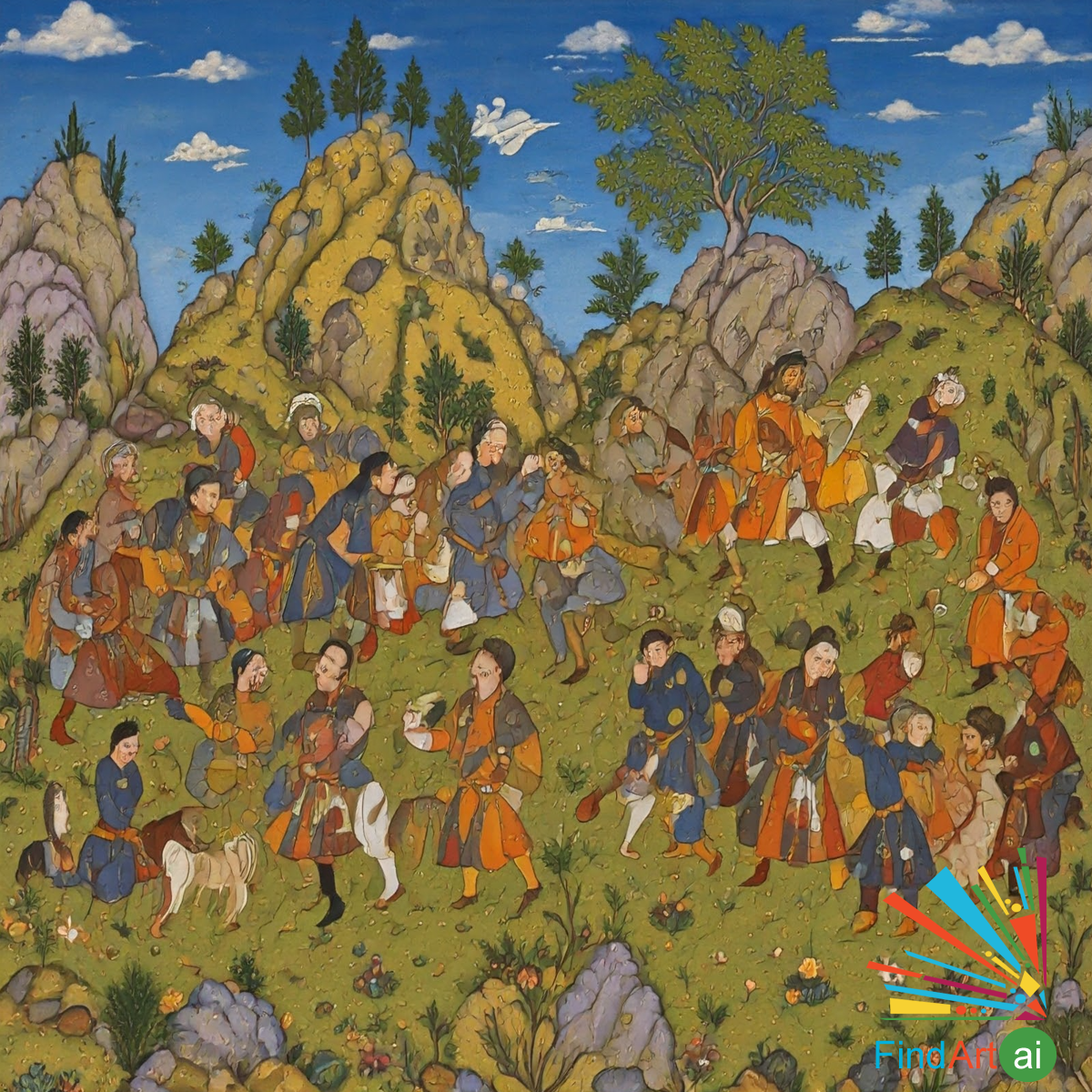
Persian Miniature Paintings with Epic Tales Theme
Persian Miniature Paintings with the Epic Tales theme are detailed, small-scale artworks that depict scenes from Persian literature, particularly from heroic and legendary stories like those found in the Shahnameh (Book of Kings), a 10th-century epic poem by Ferdowsi. These paintings showcase intricate compositions, vivid colors, and stylized figures, often illustrating grand battles, mythical creatures, and legendary heroes. The primary goal of these miniatures is to visually narrate the epic sagas that define Persian cultural identity, history, and mythology, while also emphasizing refinement, beauty, and storytelling.
Key Characteristics of Persian Miniature Paintings with the Epic Tales Theme
- Illustrations of Legendary Heroes
- Persian miniatures often feature well-known heroes from Persian epics, such as Rostam, Sohrab, and Eskandar (Alexander the Great). These characters are depicted in moments of glory, battle, or significant historical events, highlighting their bravery and wisdom.
- Example: A painting might depict Rostam fighting the mythical dragon, capturing the hero's strength and the mythical nature of the story.
- Rich Detailing and Ornate Style
- The miniature style is known for its meticulous attention to detail, from the patterned garments worn by the figures to the intricate architecture and landscapes in the background. The small scale allows for precise, decorative elements that enhance the storytelling.
- Example: In a scene from the Shahnameh, the warrior might be depicted in an ornate helmet, with each piece of armor rendered in exquisite detail, while the battlefield is filled with delicate trees, flowers, and animals.
- Vivid Colors and Gold Accents
- Persian miniatures often use a bright, vibrant palette, with deep blues, reds, golds, and greens being particularly common. Gold leaf and fine pigments enhance the luxurious and dramatic nature of the epic scenes.
- Example: A battle scene may be depicted in rich hues, with the shining armor of the warriors contrasted against a deep blue sky and golden sunlight, giving a sense of majesty and grandeur.
- Mythical Creatures and Symbolism
- Epic tales often include fantastical elements such as dragons, simurgh (a mythical bird), and other supernatural beings. Persian miniatures skillfully incorporate these creatures, using them to symbolize strength, wisdom, or divine intervention.
- Example: The simurgh might be shown rescuing a hero, with its vibrant feathers filling the scene, symbolizing the protective power of nature or the divine.
- Complex Composition and Dynamic Movement
- Despite their small size, Persian miniatures often convey complex narratives through dynamic composition. Multiple figures, sometimes overlapping or interacting in a confined space, create a sense of movement and action, typical of the epic adventures they illustrate.
- Example: In a scene of battle, several warriors might be shown mid-action, with horses rearing, weapons clashing, and dust swirling, all captured within a delicately framed composition.
- Balance of Natural and Supernatural Elements
- Persian miniature paintings strike a balance between realistic details and fantastical elements. Landscapes, architecture, and human figures are stylized yet recognizable, while mythical creatures and events are seamlessly integrated into the narrative.
- Example: A depiction of a royal hunt may show a lush garden with realistic trees and flowers, while a mythical beast appears in the background, blending the everyday with the extraordinary.
- Narrative Text Integration
- Many Persian miniatures are part of illuminated manuscripts, where the painting is accompanied by text that provides context or narration for the scene. The visual and written elements work together to bring the epic story to life.
- Example: A miniature illustrating a scene from the Shahnameh might include a verse written in calligraphy above the image, explaining the significance of the depicted event.
- Celebration of Persian Culture and History
- The stories depicted in Persian miniatures, especially epic tales, serve as a celebration of Persian cultural identity. By illustrating legendary events and heroic figures, the paintings preserve and promote Persian values such as loyalty, honor, and courage.
- Example: A miniature showing the coronation of a Persian king not only depicts a historical moment but also highlights the grandeur of Persian royalty and governance.
Common Themes in Persian Miniature Paintings with Epic Tales
- Heroic Battles and Adventures
- Many Persian miniatures focus on dramatic moments from epic battles, where the hero faces overwhelming odds or engages in combat with mythical beasts. These scenes are filled with energy and tension, emphasizing the bravery and strength of the protagonist.
- Example: A miniature might show Rostam battling the White Demon in the mountains, with vivid action conveyed through the positioning of the figures and the swirling environment around them.
- Mythological and Supernatural Beings
- Mythological creatures, such as the simurgh or dragons, play a central role in Persian epics. Their depiction in miniatures is often symbolic, representing forces of nature, protection, or danger.
- Example: The simurgh cradling the infant Zal might be depicted in a beautifully detailed landscape, representing divine guidance and wisdom.
- Courtly Life and Kingship
- Persian epics often center on the lives of kings and rulers, their triumphs, challenges, and moral dilemmas. Miniatures bring these regal stories to life, depicting opulent palaces, courtly ceremonies, and royal hunts.
- Example: A king in his throne room surrounded by courtiers might be depicted with a halo of gold, symbolizing his divine right to rule, while richly patterned carpets and ornate architecture fill the scene.
- Love and Tragedy
- Some epic tales also contain elements of romance, loyalty, and personal sacrifice. Persian miniatures capture these emotional moments with sensitivity, using delicate brushwork to convey the deep feelings of the characters.
- Example: A miniature of the tragic encounter between Rostam and his son Sohrab may depict the two locked in combat, with subtle expressions of sorrow foreshadowing the heartbreak to come.
Rostam's Victory: A Persian Miniature of Heroism Against the White Demon
In "The Triumph of Rostam," a Persian miniature depicts the legendary hero Rostam from Ferdowsi's "S...
Explore Persian Epics: Rostam & Rakhsh in a Captivating Miniature Painting of Shahnameh
Immerse yourself in the enchanting world of Persian epics with a Persian miniature painting that cap...
Legend of Rostam: Epic Persian Traditions in a Mesmerizing Miniature Painting
"The Legend of Rostam: A Hero's Journey" captures the essence of Persian epic traditions through a m...
Epic Hero's Journey: A Persian Miniature in the Enchanted Celestial Garden
"The Hero’s Journey in the Celestial Garden" invites the viewer into an epic tale depicted as a Pers...
Rostam's Epic Quest: A Persian Miniature of Heroism and Mythical Adventure
"The Valor of Rostam: The Seven Labors" invites viewers into a vibrant Persian miniature capturing t...
Rostam's Valor: Persian Miniature of Heroic Battle in Vibrant Landscape
"The Valor of Rostam: A Scene from the Shahnameh" captures the heroic essence of Rostam, the legenda...

